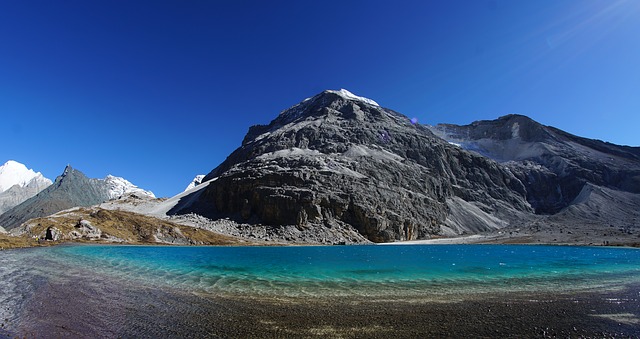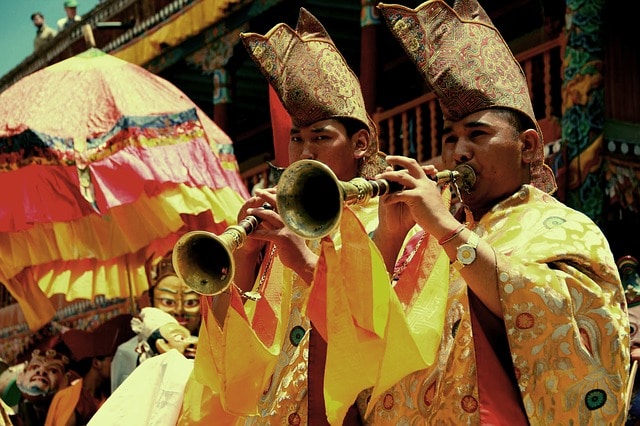Tibetan Cultures in India


Tibetan Culture in India
Tibet is best known as the land of distinct culture and rich heritage. A panorama of its ethnicity and cordiality can be observed and revered in the northern parts of India such as Himachal Pradesh and Sikkim and neighbouring countries like Nepal and China. Selective and restricted accessibility has proved to be a boon to Tibet for its essence is untouched and preserved making us fall in love with the Tibetan culture the more.
Let us unravel this holy gem and know more about it.
History
Tibet is boastful of its bone-rattling history for all the right reasons. The land of pure air and serenity, Tibet was declared as an independent nation by the 13th Dalai Lama in 1913. This beautiful nation then conceived its very own national flag, currency, army and stamps. However, China’s Communist Revolution circa 1948 led to the invasion of Tibet. Despite multiple uprisings against the Chinese government, Tibet had to give up its independence.
In 1959, the spiritual and political leader of Tibet, the 14th Dalai Lama fled with thousands of Tibetans to India. Since then, until now, the entire political control of Tibet lies in the hands of the Chinese government.
Traditions and Culture
The pious concept of Tibetan Buddhism has imprinted itself on the culture of Tibet in a genius manner. All that the rich Tibetan culture depicts today is an amalgamation of rituals, traditions and arts converged from the lands of India, Nepal and China. Music, art and literature have been aligned with the sacred Buddhist beliefs and Buddhism, in turn, has been deeply influenced by the Bon tradition introduced to the world by the Himalayas.
Tibetans are very particular when it comes to obeying the social conventions under the huge umbrella of Tibetan culture. These include:
- Walking around the stupa or religious statue clockwise
- Spinning the prayer wheels clockwise
- Not smoking as it is strictly prohibited in and around a monastery
- Not talking loudly
In order to make the most out of the essence of this gorgeous destination, it is mandatory to abide by the rules and to preserve the godliness of Tibet in our own little way.
Some interesting things you should know about Tibetan culture and traditions include:
- The authentic “Butter Tea”, traditionally known as Po Cha, is a subtle blend of tea leaves, yak butter, salt and water.
- The Tibetan Dzo is an animal that is a hybrid of the Tibetan yak and domestic cattle. It is larger in size and stronger in strength as compared to both and yields more milk and meat.
- When in Tibet, make sure you enjoy the Nangma dance music in the karaoke bars of Lhasa.
All of this sums up to the unique yet diverse culture of Tibet and experiencing the same is surreal and definitely, memorable.
Similar culture and diversity is reflected in various other destinations of India mainly Bhutan. Check out Bhutan Tour Packages for such experiences!
Also read: Fun Facts About Bhutan
Religion
Tibet is a not very much diverse when it comes to religion. Almost everyone in Tibet follows and preaches Buddhism. As a result, almost all citizens of Tibet are Tibetan Buddhists. The folk tales of Tibet narrate the heavy influence of the pre-Buddhist Bon religion that adheres to exorcism, spells and spirits.
Himachal Tourism and Bhutan Tourism are strongly inspired by the religion in Tibet along with other destinations such as Nepal and Sikkim.
Festivals
Festivals are a way of life in Tibet. The people of Tibet actively participate in all Tibetan festivals and celebrate life to the fullest. It is such jollity and enthusiasm that makes people admire Tibet all the more. These include:
- Losar: Losar is Tibet’s New Year which is celebrated in the month of February or March wherein the date corresponds to the first day of the lunisolar Tibetan calendar.
- Shoton: Shoton is celebrated to mark the end of the hundred day’s summer retreat of all the monks. It commences with the unveiling of an embroidered 500-square meter portrait of the Buddha. After this, the people of Tibet indulge in dance, music, arts and gluttony which make it the liveliest festival of Tibet.
- The Bathing Festival: The Bathing Festival is considered healthy to the body and lasts for a week starting from the 7th month of the Tibetan calendar. It is believed that during this time of the year, the water in Tibet is sweet, cool, soft, light, clean, clear and absolutely kind to the throat and the belly. All of Tibet participates in this festival to free themselves from any and all illnesses since the water is considered holiest during this time.
Also read: Let’s Get To Know Bhutan and Its Culture of Buddhism
Essence of Tibet
The widespread charm of Tibet and its true essence can be well understood and preached through the following:
Prayer Flags
Prayer flags can be seen in abundance in Ladakh, Himachal Pradesh and other north eastern regions. Legend narrates that Tibetans used these flags as a sign of protection during wars. Even today, people hang prayer flags outside their house or in windy regions such as the river side or high spots. The flags comprise of five colours that depict symbolise the elements of nature. Blue means wind, white means air, red is fire, green is water and yellow is Earth. Prayer flags are an epitome of peace and harmony and have messages of hope and wisdom printed on them.
Tibetan Thangka Painting
The inception of the Thangka painting can be traced back to the seventh century. “Thangka” means painting in Tibetan and means painting. It is an art form that paints Tibetan deities and philosophers such as Lord Buddha and is of great help to those who meditate.
Tibetan Monasteries
All Buddhists practice the deep and peaceful ritual of Monasticism wherein monks and nuns learn, teach and preach the rituals and practices of Buddhism. Ladakh Tourism and many such Tibetan-influenced destinations are embellished with monasteries of architectural excellence and beauty. These are peaceful centres where philosophical principles are learned, discussed and debated.
Also read: The Daily Life Of Bhutanese Monks
Tibet In The Present
In the present times, Tibet has engulfed itself into the hustle and bustle of the city life. However, its sustained sanctity and serenity is still an amazing aspect that lures people towards it.
Under the Chinese rule, Tibetans are restricted from communicating beyond borders. Even then, the citizens of Tibet have found ways to stay rightly connected to the outside world. The younger generation brings in the dawn of revolution through the “White Wednesday” movement, traditionally known as the Lhakar, to preserve and enhance the Tibetan culture. During this festival, Tibetans communicate in their own language, wear Tibetan clothes and express their rejection towards every Chinese rule or obligation.
Tibet is literally the definition of paradise on Earth and it is an experience of a life time to explore its truest essence. Various destinations such as Nepal, Ladakh and Himachal Pradesh will give you a gist of the rich and warm culture in Tibet. Check out India Tour Packages to know more!
Related Reads: Why You Must Visit Leh Ladakh Once In A Lifetime | Himachal Pradesh – A Complete Tour Guide
Recent Posts
Top Places For Monsoon Treks in Maharashtra
Maharashtra transforms into a lush green paradise during the monsoon season, offering some of India's…
Know Why You Should Visit Lonavala in Monsoon
Monsoon and Lonavala are like a match made in heaven, a harmonious union that showcases…
Explore the List of Top Lonavala Waterfalls That You Must Visit This Monsoon
Monsoon season brings a magical transformation to the lush landscapes of Lonavala, making it a…
Why is Mahabaleshwar in Monsoon a Real Treat?
Nestled in the picturesque Western Ghats of Maharashtra, India, Mahabaleshwar is a hill station that…
Top 15 Delightful Monsoon Destinations in Maharashtra
Monsoon in Maharashtra is a magical time when the state transforms into a lush green…
Top 10 Beautiful Places to Visit Near Pune in Monsoon
As the scorching summer heat subsides and the first drops of rain touch the earth,…



